Lam Research Bundle
How did Lam Research Rise to Semiconductor Dominance?
Founded in 1980, Lam Research has been a pivotal player in the semiconductor industry, revolutionizing chip manufacturing. Initially focused on plasma etching equipment, the company quickly established itself as a key innovator. This focus propelled Lam Research SWOT Analysis to become a cornerstone in the production of advanced memory and logic devices.
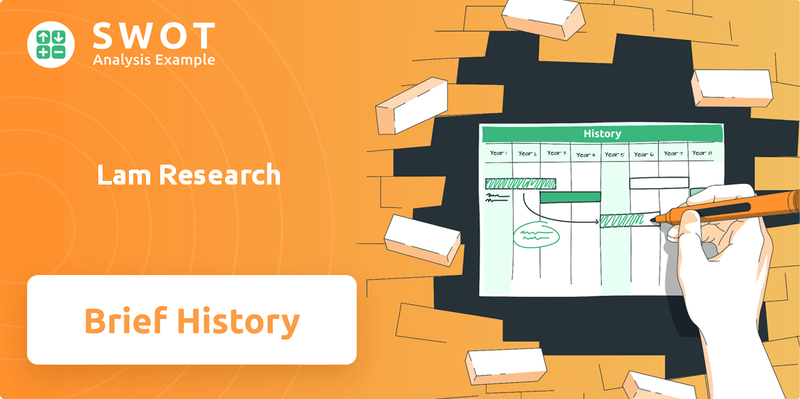
From its humble beginnings in Fremont, California, Lam Company has grown into a global leader, boasting a significant market share in the wafer fabrication equipment (WFE) segment. With impressive financial results, including $17.136 billion in revenue for the twelve months ending March 31, 2025, Lam Research's commitment to innovation and strategic positioning has been crucial to its evolution. This brief history of Lam Research Corporation will explore its journey, achievements, and its impact on the ever-evolving semiconductor industry, including its position as an Applied Materials competitor.
What is the Lam Research Founding Story?
The story of Lam Research begins with its founder, David K. Lam. He established the company on January 21, 1980, with a clear vision to innovate in the semiconductor manufacturing process. His goal was to create advanced plasma etching equipment, essential for the miniaturization of semiconductor wafers, a critical need in the burgeoning tech industry.
Lam's background, which included experience at Xerox, Hewlett-Packard, and Texas Instruments, equipped him with the expertise to identify this opportunity. He saw that existing technologies were insufficient for the demands of the time. This led him to develop the next generation of plasma etchers for production use.
David Lam was the sole founder, but he was instrumental in bringing in talented individuals like George Koch and Steve Muto early on. Initial funding came from venture capital and private investments. Seed capital from his widowed mother also played a role. The timing was favorable, coinciding with the growth of the venture capital industry due to a reduction in capital gains tax.
Lam Research's early focus was on providing innovative wafer fabrication equipment and services to the semiconductor industry. In 1981, the company launched its first product, the AutoEtch 480, an automated polysilicon plasma etcher. The name 'AutoEtch' highlighted its automated nature, and the '80' in '480' represented the founding year, 1980.
- David K. Lam founded Lam Research on January 21, 1980.
- The company's initial focus was on creating advanced plasma etching equipment.
- The first product, the AutoEtch 480, was introduced in 1981.
- Bob Noyce, the founder of Intel, provided support in refining the business plan.
Lam Research SWOT Analysis
- Complete SWOT Breakdown
- Fully Customizable
- Editable in Excel & Word
- Professional Formatting
- Investor-Ready Format
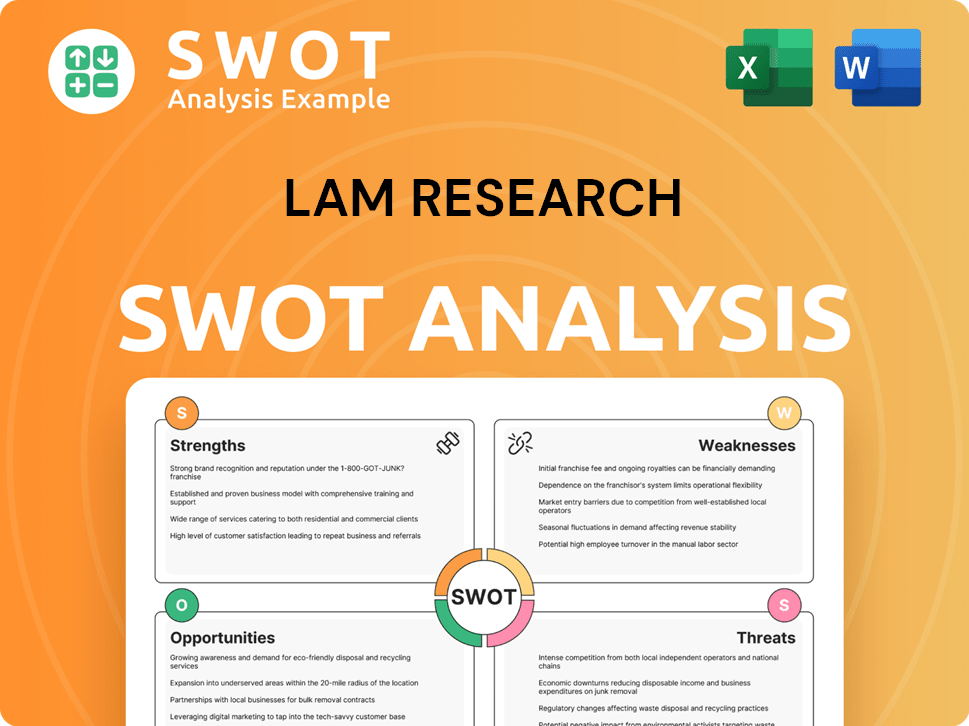
What Drove the Early Growth of Lam Research?
The early years of Lam Research saw significant growth and strategic expansions. Following the sale of its first AutoEtch 480 system, the company quickly evolved, marked by key leadership changes and substantial financial milestones. This period was crucial in establishing Lam Research's foundation in the semiconductor equipment market. The Target Market of Lam Research was also beginning to take shape during this time.
Roger Emerick became CEO of Lam Research in 1982, a pivotal move that coincided with the company's early sales growth. Sales saw significant increases in 1983, setting the stage for future expansion. This early success was fundamental to Lam Research's trajectory in the semiconductor equipment sector.
A critical event in Lam Research's history was its IPO in May 1984. Listed on Nasdaq under the symbol LRCX, the IPO raised approximately $20 million. This influx of capital was essential for accelerating development and expansion, fueling Lam Research's growth.
In the mid-1980s, Lam Research began its global expansion, focusing on key markets. Customer support centers were established across Europe, the United States, and Japan. By the early 1990s, the company had a strong presence in Asian markets, including China, Korea, Singapore, and Taiwan.
Lam Research consistently introduced innovative products during this period. Key launches included the Integrity system in 1990 and the Transformer Coupled Plasma (TCP) technology in 1992. These advancements provided more efficient and cost-effective etching capabilities, enhancing its competitive edge in the semiconductor equipment market.
Lam Research PESTLE Analysis
- Covers All 6 PESTLE Categories
- No Research Needed – Save Hours of Work
- Built by Experts, Trusted by Consultants
- Instant Download, Ready to Use
- 100% Editable, Fully Customizable
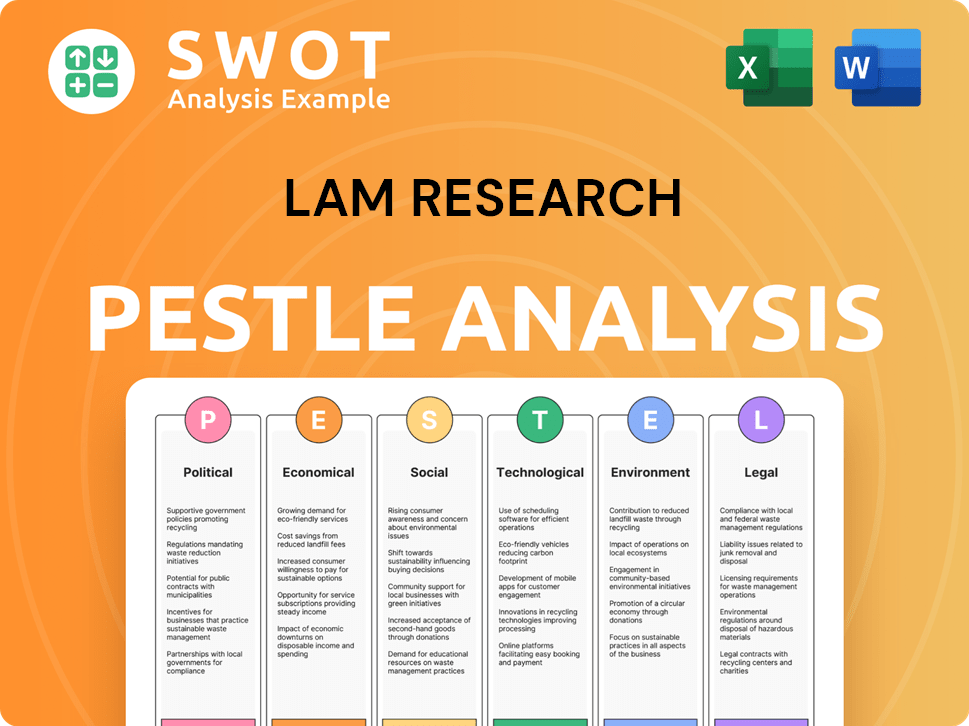
What are the key Milestones in Lam Research history?
The journey of Lam Research, a key player in the semiconductor equipment industry, is marked by significant milestones, technological advancements, and strategic adaptations. From its early days, Lam Company has consistently pushed the boundaries of wafer fabrication technology, establishing itself as a leader in the field. The company's history reflects its commitment to innovation and its ability to navigate the dynamic challenges of the semiconductor market. To understand more about the company's ownership, you can explore Owners & Shareholders of Lam Research.
| Year | Milestone |
|---|---|
| 1981 | Introduced the AutoEtch 480, the industry's first fully automated plasma etching system. |
| 1992 | Launched Transformer Coupled Plasma (TCP) technology, enhancing etching precision. |
| 2018 | Tim Archer became CEO, marking a new phase of leadership. |
| 2024 | SABRE 3D platform revenue more than doubled, highlighting growth in 3D package production. |
| 2025 (March 31) | R&D expenses reached $2.014 billion, underscoring continued investment in innovation. |
Lam Research has consistently been at the forefront of technological innovation, driving advancements in semiconductor manufacturing. The company's focus on research and development has resulted in breakthroughs like the Akara etch system and the Altus Halo deposition tool, which are pivotal for next-generation semiconductor production.
The introduction of the AutoEtch 480 in 1981 marked a significant leap in automation for the semiconductor industry. This innovation set the stage for more efficient and precise etching processes.
The Transformer Coupled Plasma (TCP) technology, introduced in 1992, provided a cost-effective method for high-detail etching. This advancement significantly improved the performance of Lam Research etching systems.
Lam Research has integrated molybdenum into its processes, enhancing the capabilities of NAND flash memory. This has improved the performance and density of memory chips.
The development of selective etch tools has enabled the creation of advanced GAA (Gate-All-Around) nodes. These tools are critical for manufacturing next-generation processors.
The SABRE 3D platform has been crucial for advancements in 3D package production. This platform has helped to improve the performance and efficiency of advanced packaging technologies.
The Altus Halo deposition tool has enabled the mass production of molybdenum, a key material for advanced 3D NAND and logic fabs. This has improved the manufacturing of advanced semiconductor devices.
Lam Research has faced several challenges, including cyclical market downturns and geopolitical tensions. The company has also navigated strategic shifts and leadership transitions to maintain its position in the competitive semiconductor equipment market.
The semiconductor industry is inherently cyclical, with periods of high demand followed by downturns. Lam Research must manage its operations and investments to adapt to these fluctuations.
Geopolitical factors, such as export controls and trade tensions, have presented challenges, particularly concerning China. These factors impact the company's revenue streams and market access.
The failed acquisition of KLA-Tencor in 2015, a $10.6 billion deal, highlighted the complexities of industry consolidation. This event underscored the strategic challenges faced by Lam Research.
Leadership transitions, such as Tim Archer becoming CEO in 2018, have required the company to adapt. These changes can impact the strategic direction and operational focus of the company.
The company's substantial investment in R&D, with expenses reaching nearly $1.9 billion in 2024 and $2.014 billion for the twelve months ending March 31, 2025, reflects its commitment to innovation. This investment is crucial for maintaining its competitive edge.
In Q4 2024, China's share of Lam Research's overall revenue was expected to normalize to around 30%. This shows the importance of adapting to changing market dynamics in key regions.
Lam Research Business Model Canvas
- Complete 9-Block Business Model Canvas
- Effortlessly Communicate Your Business Strategy
- Investor-Ready BMC Format
- 100% Editable and Customizable
- Clear and Structured Layout
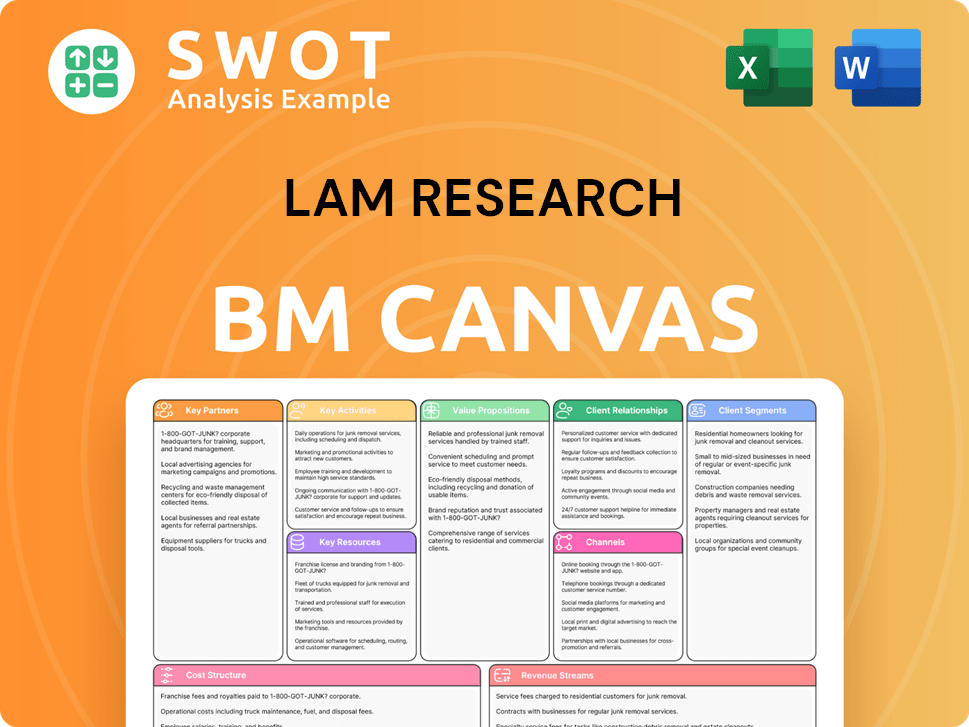
What is the Timeline of Key Events for Lam Research?
The Lam Research history began in 1980 when David K. Lam founded the company in Fremont, California. Over the years, Lam Company has grown significantly, marked by key technological advancements, strategic acquisitions, and expansions into global markets. The company's journey includes its initial public offering in 1984, the introduction of groundbreaking technologies like TCP, and major acquisitions such as Novellus Systems in 2012. These milestones have shaped Lam Research into a key player in the semiconductor equipment industry.
| Year | Key Event |
|---|---|
| 1980 | David K. Lam founded Lam Research Corporation in Fremont, California. |
| 1981 | The company introduced the AutoEtch 480, its first product. |
| 1982 | First AutoEtch 480 system sold; Roger Emerick appointed CEO. |
| 1984 | Lam Research went public on Nasdaq (LRCX), raising $20 million. |
| 1990 | Introduction of the Integrity system. |
| 1992 | Company debuted Transformer Coupled Plasma (TCP) technology. |
| 1997 | Merges with OnTrak Systems, Inc., expanding product offerings. |
| 2006 | Acquired Bullen Semiconductor (now Silfex, Inc.). |
| 2008 | Acquired SEZ AG (now Lam Research AG). |
| 2012 | Completed the $3.3 billion acquisition of Novellus Systems, Inc. |
| 2015 | Attempted to acquire KLA-Tencor for $10.6 billion, but the deal did not proceed. |
| 2016 | Joined the Fortune 500 for the first time. |
| 2018 | Tim Archer is named President and CEO. |
| 2021 | Opened a manufacturing facility in Batu Kawan, Malaysia. |
| 2023 | Acquired Esgee Technologies in January. |
The semiconductor industry is projected to grow significantly, with global sales expected to increase by 16.0% in 2024 and 12.5% in 2025. This growth is driven by increasing adoption of AI, 5G infrastructure, and the Internet of Things. Lam Research is strategically positioned to benefit from these trends, particularly in the wafer fabrication equipment (WFE) segment, which is expected to reach approximately $100 billion in 2025.
Lam Research is focusing on advancements in memory technologies, especially NAND flash, crucial for data-intensive AI applications. A significant growth opportunity lies in NAND upgrades, with a potential $40 billion market for upgrades. The company anticipates a recovery in NAND spending, driven by technology upgrades, as two-thirds of NAND customers operate below 200 layers.
Lam Research is committed to investing in research and development, with an estimated R&D investment of $4.6 billion for fiscal year 2024. Strategic initiatives include expanding its presence in key markets like China, Korea, and Taiwan, while also diversifying its product portfolio. Despite anticipated declines in Chinese revenue, the company identifies advanced manufacturing and packaging as primary growth drivers.
The company forecasts Q2 FY2025 revenue between $4.0 billion and $4.6 billion, with a gross margin of 46%–48%. Lam Research's long-term vision remains tied to its founding purpose: enabling the advancement of semiconductor capabilities and performance, contributing to the proliferation of technology in everyday life. The WFE market is expected to grow by 2.8% to $98 billion in 2024.
Lam Research Porter's Five Forces Analysis
- Covers All 5 Competitive Forces in Detail
- Structured for Consultants, Students, and Founders
- 100% Editable in Microsoft Word & Excel
- Instant Digital Download – Use Immediately
- Compatible with Mac & PC – Fully Unlocked
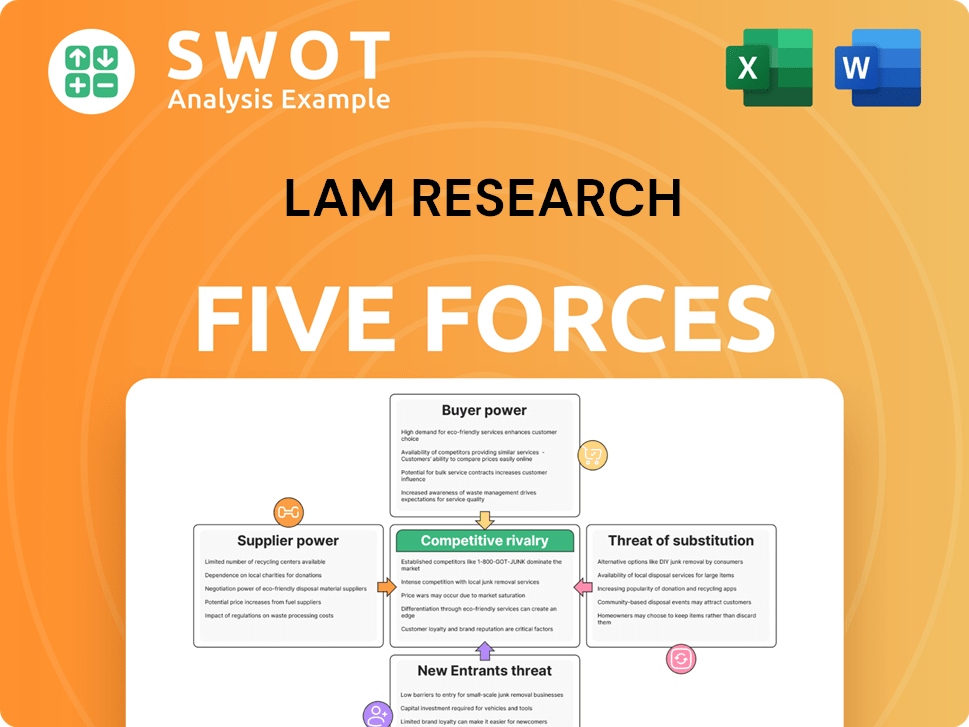
Related Blogs
- What is Competitive Landscape of Lam Research Company?
- What is Growth Strategy and Future Prospects of Lam Research Company?
- How Does Lam Research Company Work?
- What is Sales and Marketing Strategy of Lam Research Company?
- What is Brief History of Lam Research Company?
- Who Owns Lam Research Company?
- What is Customer Demographics and Target Market of Lam Research Company?
Disclaimer
All information, articles, and product details provided on this website are for general informational and educational purposes only. We do not claim any ownership over, nor do we intend to infringe upon, any trademarks, copyrights, logos, brand names, or other intellectual property mentioned or depicted on this site. Such intellectual property remains the property of its respective owners, and any references here are made solely for identification or informational purposes, without implying any affiliation, endorsement, or partnership.
We make no representations or warranties, express or implied, regarding the accuracy, completeness, or suitability of any content or products presented. Nothing on this website should be construed as legal, tax, investment, financial, medical, or other professional advice. In addition, no part of this site—including articles or product references—constitutes a solicitation, recommendation, endorsement, advertisement, or offer to buy or sell any securities, franchises, or other financial instruments, particularly in jurisdictions where such activity would be unlawful.
All content is of a general nature and may not address the specific circumstances of any individual or entity. It is not a substitute for professional advice or services. Any actions you take based on the information provided here are strictly at your own risk. You accept full responsibility for any decisions or outcomes arising from your use of this website and agree to release us from any liability in connection with your use of, or reliance upon, the content or products found herein.